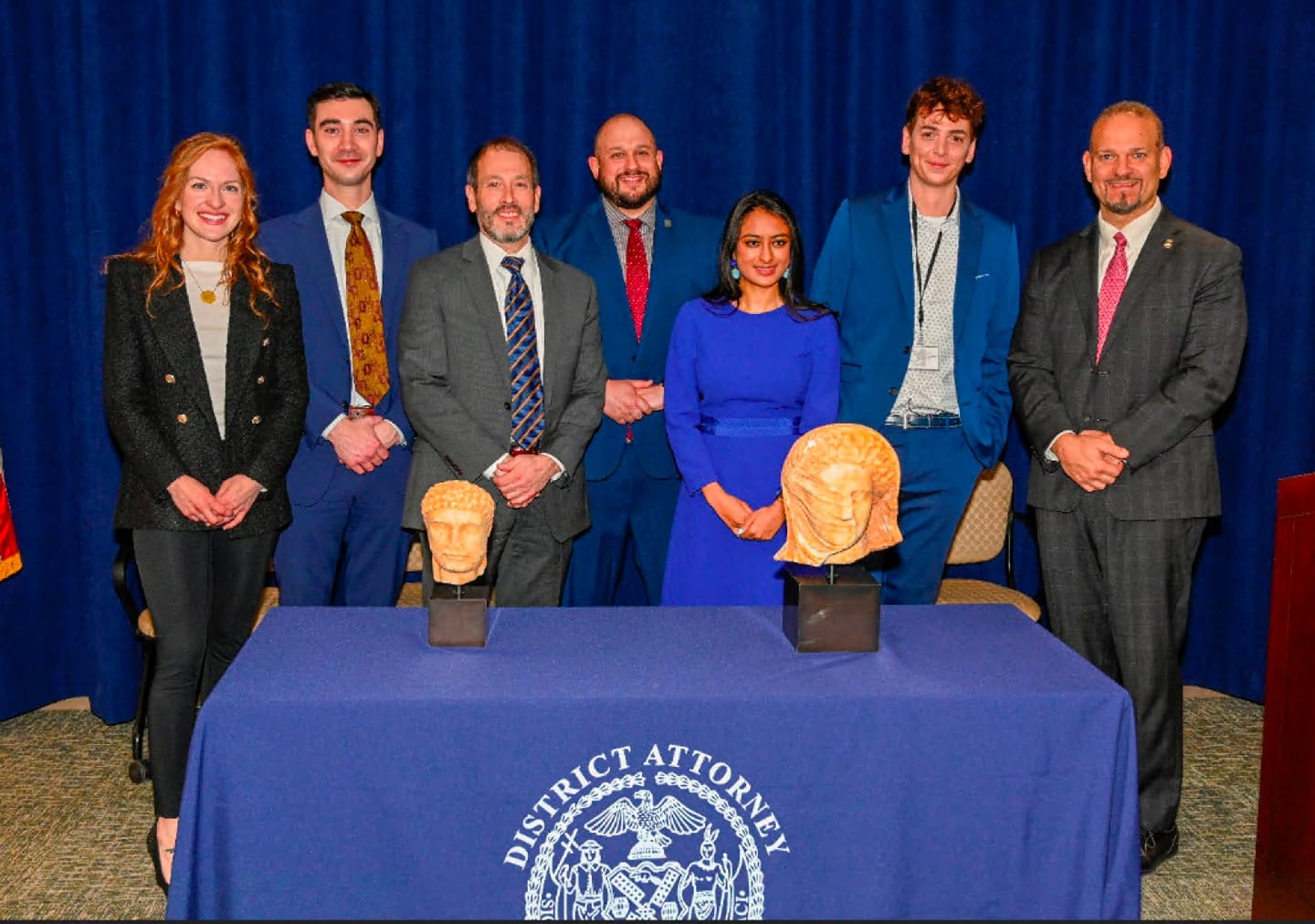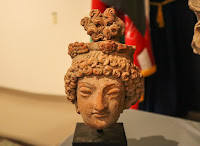 Antiquities; Looting; Smuggling; Collecting;,Cyrene,Homeland Security Investigations,illicit cultural property,Libya,Manhattan District Attorney,Matthew Bogdanos,Morgan Belzic
Antiquities; Looting; Smuggling; Collecting;,Cyrene,Homeland Security Investigations,illicit cultural property,Libya,Manhattan District Attorney,Matthew Bogdanos,Morgan Belzic
 No comments
No comments
The sometimes slow and sometimes fast return of historical artefacts pillaged from Libya
 |
| Cyrene, Northern Necropolis. The Sculptured Tomb/Cassels from Pacho 1827 |
Parallel with the start of the First Libyan Civil War, the Security Directorate of Shahat, in the eastern coastal region of Libya, implemented a series of works in an attempt to address the looting and destruction of moveable and immovable heritage from the tangle of ruins known as the seventh century BCE city of Cyrene. Faced with rising civil unrest, the outbreak of wars, and unchecked and destructive urban encroachment, Ismail Dakhil, an official at the museums department of eastern Libya, estimated that as much as 30 percent of the ancient city may have been encroached upon due to urban expansion.
Along with urban encroachment, insufficient security and a complicated political terrain has made Libya's rich archaeological heritage a vulnerable target for looting. During the last two decades, according to the research of prominent forensic archaeologists, many of the territory's majestic Hellenistic sculptures have been plundered, only to turn up for sale on the ancient art market with little or fabricated provenance. Many of the most beautiful of these pieces have turned up with, or have been sold through well known gallerists in London, Paris, Switzerland, Barcelona, and the United States.
 |
| Cyrene Deity Head - Belzic Dt.54 * |
The first, and oldest, is a fourth-to-third-century BCE Head of a Veiled Woman, (Cyrene Deity Head - Belzic Dt.54) which was recovered as part of an 11-year Federal investigation code named “Operation Lost Treasure,” led by HSI-ICE in New York, in conjunction with the U.S. Department of State and U.S. Customs and Border Protection. This 13 inch tall by 10 inches wide marble head was seized by US authorities while monitoring the shipments and way bills of a known problematic Sharjah-based antiquities dealer. The artefact was being shipped to a sometimes collector, sometimes dealer operating in New York. Unfortunately, this was not the only plundered artefact from Cyrene the UAE dealer knowingly handled, nor was America the only country where buyers for Libya's plundered material could easily be found.
Freshly looted, this severed head of a divinity had been shipped out of Libya and made her way into the United States unwashed by her handlers. As a specimen of the wonders of Cyrenaica's past, her expressive face still retains some of the underdrawing pigment used by her creator to outline and define her eyes.
Officers involved in the U.S. investigation would go on to provide assistance to London investigators when this same dealer, continuing to ply his illegal trade in the lucrative London market, shipped yet another plundered funerary statue from Cyrene to the United Kingdom just three years after this New York seizure. In the US case, Immigration and Customs Enforcement’s (ICE) Homeland Security Investigations (HSI) International Operations Division Chief Leo Lin formally handed over this sculpture to the safekeeping of the Libyan Embassy in Washington DC, where it has remained until its journey home was finalised last week.
Artefact #2
 |
| Cyrene Deity- Steinhardt-Albertson Dt.76* |
- Michael Ward & Co.
- Michael Ward Inc.,
- Ward & Company Works of Art LLC.
 |
| Handover Ceremony in Manhattan |
Through the collaborative work of the DA's team, with the coordinated help of Special Agents Robert Mancene, Robert Fromkin, and John Labatt of Homeland Security Investigations, in this one case alone, the DA's office successfully identified 169 of the 180 seized antiquities as having been trafficked by a total of 12 different criminal smuggling networks. The remaining eleven forfeited antiquities, including this one, first appeared on the international art market in the hands of dealers more concerned with the artefact's sales value than with closely examining the provenance of objects that come from countries plagued by civil unrest, war, and/or rampant looting.
 |
| Cyrene Deity Head - Belzic Dt.22* |
While the exact dates of when the 3rd to 2nd century BCE, Belzic Dt.22, was looted from Cyrene is unknown, it is believed that this sculpture may have been stolen in the 1980s and then smuggled into Egypt by antiquities traffickers. Investigators in New York have proven that it was eventually shipped onward to the United States, where it appeared on the US ancient art market in 1997. According to investigators, the artefact demonstrated the “telltale signs of looting such as earth on the surface and new chips at the base and in the veil.”
By 1998, and now referred to as the Veiled Head of a Lady, and head had been valued at nearly half a million dollars and was placed on loan to the Metropolitan Museum of Art in New York by an anonymous donor, where it was catalogued simply as a Greek Hellenistic funerary head and mislabelled as being from the 4th century BCE.
The veiled head remained on display at the Met for more than twenty years. After being identified as having come from Cyrene, the sculpture was seized during an investigation conducted by Manhattan District Attorney Alvin Bragg's team, lead by Chief of the Antiquities Trafficking Unit and Senior Trial Counsel Matthew Bogdanos, along with Supervising Investigative Analyst Apsara Iyer and Investigative Analysts Alyssa Thiel and Daniel Healey in February 2022. Note that the Met and DANY have declined to identify the lender at this time, given the sensitivity of ongoing investigations.
Prior to its formal transfer back home to Libya, the Veiled Head of a Female was handed over to the Libyan authorities on 30 March 2022 along with Artefact 4 during a repatriation ceremony attended by the Charge d’Affaires of the Embassy of Libya in DC Khaled Daief, and U.S. Homeland Security Investigations (“HSI”) Acting Deputy Special Agent-in-Charge Mike Alfonso.
Artefact #4
 |
| Cyrene Portrait Head - Belzic P.97* |
After being smuggled from Libya to Geneva, Switzerland, Morgan Belzic first identified this 2nd century CE marble Cyrenaican Funerary portrait of a bearded man on the ancient art market in November 2018. When documented, it was being offered for an estimated sales price of $19,000.
Originally placed in a tomb rich with small niches, there are more than 250 Cyrene portraits of this category recorded by scholars studying the ancient remains of Libya. The iconographic styling of this type of portrait head is so unique to Cyrenaican funerary imagery that this category of sculpture is referred to in scientific literature as a ‘Romano-Libyan’ portrait.
The marble head of a man was next offered for sale two years later, in June of 2020, this time in Manhattan and with an asking price of $25,000 - $35,000. But it is the third sale which turns out to be the charm, resulting in the fastest seizure to restitution of an artefact in history.
Belzic P-97 was spotted for the third time on 28 March 2022, this time by art historian Camille Blancher, just shy of its next intended sale date through another USA antiquities dealer. Through the responsive and collaborative efforts of Manhattan District Attorney Alvin Bragg's antiquities unit, working in close coordination with Special Agents Robert Mancene and Robert Fromkin of Homeland Security Investigations the bearded head of a man was seized on Tuesday, March 29th, back in the Manhattan DA's office where it was handed over to the Libyan authorities on Wednesday, March 30th, along with Artefact 3 during a repatriation ceremony attended by the Charge d’Affaires of the Embassy of Libya in DC Khaled Daief, and U.S. Homeland Security Investigations (“HSI”) Acting Deputy Special Agent-in-Charge Mike Alfonso.
Support for this case came from members of a coalition of archaeological missions working in Libya under the coordination of the French Archaeological Mission as well as from ARCA, all of whom are deeply committed in assisting Libyan institutions and authorities in enforcing the protection of cultural heritage in Libya and who voiced their collective concerns to the DANY regarding the artefact's potential sale.
To put a nice bow on this story, all four marble funerary sculptures, along with a small grouping of terracotta urns and fragments, were flown via private jet, paid for by a philanthropist, to Mitiga International Airport in Libya. Arriving to Tripoli on Thursday, April 1st, the repatriation of these antiquities is a “peace dividend” as described by Director-General of the United Nations Regional Institute for Crime and Justice Research (UNICRI) Antonia Marie de Meo, who led a delegation to Libya alongside James Shaw, Chief of that agency's Asset Recovery and Illicit Financial Flows programme. Also on board was forensic archaeologist Morgan Belzic, who more than anyone, truly understood the efforts, coordination and cooperation, these four recoveries required.The handover ceremony took place at the Museum of Libya inside the former royal palace of Qasr al-Khild in Tripoli. Like other museums in Libya, it has remained closed to the public since the 2011 Libyan uprising. Speeches at the event included statements made by Omar Kati, Deputy Minister for International Cooperation and Organizations Affairs, Libyan government antiquities chief Muhammad Faraj al-Falous, the envoy for Libya in the United States, representatives from the Libyan Ministry of the Interior and LARMO. Many of whom present for the celebration expressed gratitude for the efforts made by the US law enforcement and public prosecutors in bringing Libya's heritage home.
U.S. Ambassador to Libya Richard Norland personally thanked the staff at the Manhattan DA's office and HSI- ICE.
The spectacular ruins of the ancient Greek city of Cyrene have, for better or worse, survived Libya's 2011 revolution. Looking at these beautiful artefacts and admiring the Met recovered piece in particular, I feel compelled to admire the learned skill thatwent into the creation of this veiled woman. For all our modern capabilities, I doubt we could turn such solid stone into the modesty of a semi transparent fold of material in quite the way that this unknown ancient Cyrene artisan did.
Filledwith admiration, but also a healthy does of cynicism, I understand that Libya's loses don't stop with the return of one woman behind one transparent veil to the place she was formed. The rape of historic Cyrene for profit has and likely will continue, and there are other veiled faces of other victims still out there.
Some of the forensic archaeologists involved in this fight were already back at work on Saturday, prepared to help law enforcement authorities in any way they can to bring Libya's sculptures back to a country that has already lost so much.
By Lynda Albertson, ARCA CEO
-------
Addendum:
In July 2016 UNESCO placed all five of Libya's World Heritage sites on the UNESCO World Heritage in Danger list. Equally concerned, and in response to a long history of threats, the United States and Libya signed its 17th cultural property agreement with Libya on 23 February 2018 to solidify the two countries' joint collaboration in combatting the looting and trafficking of cultural objects originating from the plagued North African country.























